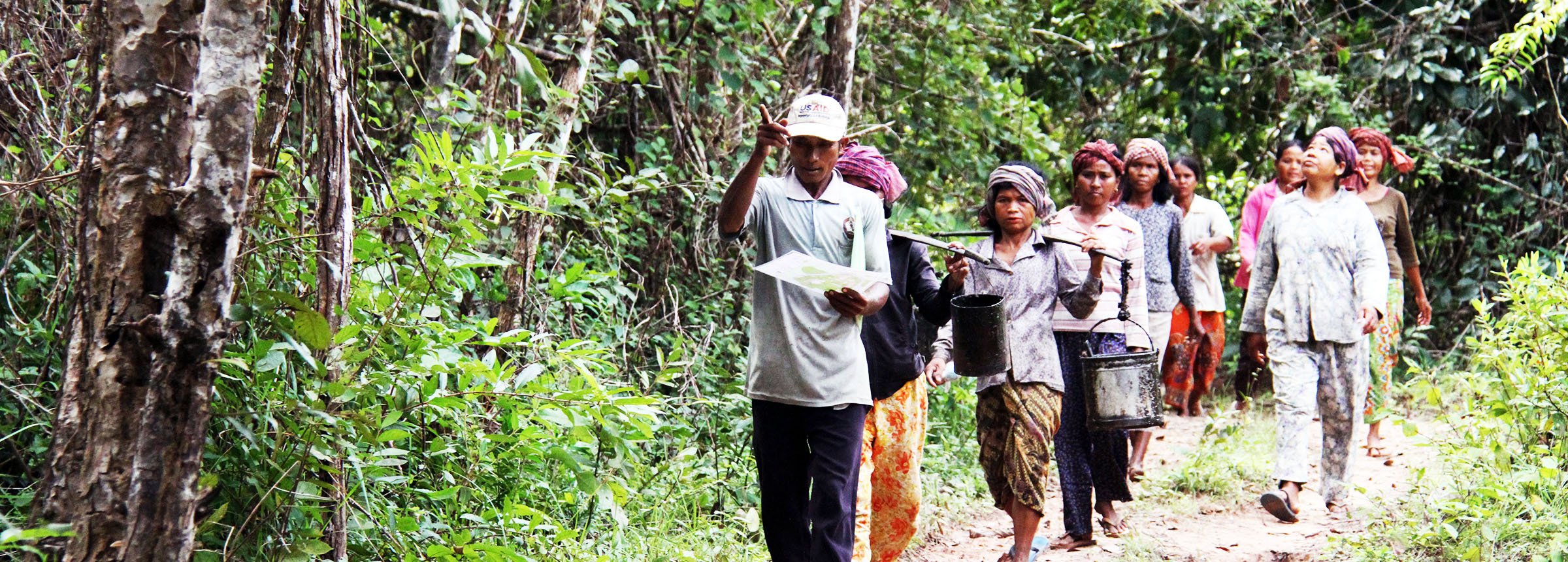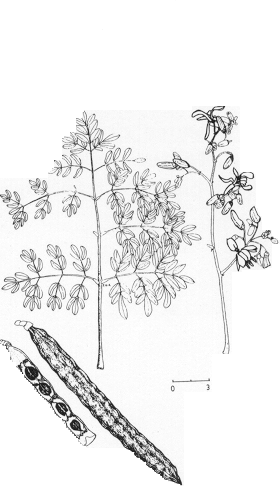
Moringa oleifera: A Perfect Tree for Home Gardens
A publication of The Agroforestry Information Service
1010 Holomua Road, Paia, Hawaii 96779-6744 USA April 1993
Moringa oleifera, commonly called the ‘drumstick tree’, is well known for its multi-purpose attributes, wide adaptability, and ease of establishment. Its leaves, pods and flowers are packed with nutrients important to both humans and animals.
 Botany.
Botany.
Drumstick is a small, fast-growing, drought deciduous tree or shrub that reaches 12 m in height at maturity. It has a wide-open, typically umbrella- shaped crown and usually, a single stem. Its wood is soft and its bark is light. It tends to be deeply rooted. (F/FRED, 1992) Its leaves are imparipinnate–rachis 3 to 6 cm long with 2 to 6 pairs of pinnules. Each pinnule has 3 to 5 obovate leaflets that are 1 to 2 cm long (von Maydell, 1986). The terminal leaflet is often slightly larger.
Its leaflets are quite pale when young, but become richer in color with maturity. Cream-colored flowers emerge in sweet-smelling panicles during periods of drought–or stress–when the tree loses its leaves. The pods are triangular in cross-section-30 to 50 cm long-and legume-like in appearance. The oily seeds are black and winged.
Ecology.
Drumstick readily colonizes stream-banks and savanna areas where the soil is well-drained and the water table remains fairly high year-round. It is usually cultivated in home gardens and courtyards, where it is most useful. It produces lots of palatable green foliage. Leaf production is increased with frequent additions of kitchen and waste water.
Moringa oleifera is adapted to a wide range of soil types but it does best in a well-drained loam to clay loam. It does not withstand prolonged waterlogging. It is observed to prefer a neutral to slightly acidic soil reaction, but it has recently been introduced with success to Pacific atolls where soil pH is commonly greater than 8.5. It does best where temperature ranges from 26 to 40oC and annual rainfall totals at least 500 mm. It grows well from sea level to 1000 m in elevation.
Moringa is quite drought tolerant, but it yields much less foliage where it is continuously under water- stress. Where annual rainfall is below 300 mm, the tree requires a relatively high water table to be productive.
Distribution.
Moringa oleifera has its origin in Arabia and India. Today the tree is a common to landscapes all over the tropics of the Old World–from south Asia to West Africa (von Maydell, 1986). It is most visible in parts of East and South Africa. It is now also finding its way into gardens on many Pacific islands–from Kiribati to the Northern Marianas.
Uses.
Moringa oleifera is one of the most useful trees for semi-arid and drought-prone areas. It is quite often found next to kitchens and in courtyard gardens where its succulent leaves are harvested daily for soups, sauces, or salads. These palatable leaves are high in protein, vitamin A and vitamin C. Where diets lack in these essential nutrients–like on Pacific atolls–the Drumstick tree makes a major contribution to human health.
Moringa is not a nitrogen fixing tree, but its fruit, flowers and leaves all contain 5 to 10 % protein-on average. All of these parts are eaten widely as vegetables, providing excellent food for both humans and animals. The pods are often cooked and eaten like green beans. The root tastes similar to horse radish and is a popular food in East Africa. Moringa flowers also produce a good honey.
The wood is light, but provides a fairly good fuel for cooking. It has a density of 0.5 to 0.7 and yields approximately 4,600 kcal/kg (F/FR.F-D, 1992). The bark contains a gum that is used as a seasoning and a treatment for some stomach ailments. Various parts of the Moringa plant are also used in medicines as diuretics and treatments for bladder ailments.
The seed is often used to purify dirty or cloudy drinking water. It is pounded into small fragments, wrapped in some sort of cloth, and then placed into water jars or containers. This pounded seed acts as a flocculent, taking impurities out of the water solution. In the Nile Valley, the name of the tree is ‘Shagara al Rauwaq’ which means ‘tree for purifying’ (von Maydell, 1986).
Planted as a hedge in courtyards, Moringa oleifera provides wind protection, shade and support for climbing garden plants. One can easily understand the popularity of this versatile and adaptable tree in many locations as a household/garden component.
Moringa seed contains about 35% oil. Sweet and non- sticking, this oil is often extracted for cooking and in rare cases, even lubrication purposes. It does not turn rancid, is excellent in salads, can be used for soap making, and burns without smoke (von Maydell, 1986).
In India, economic analysis has illustrated that cultivation of Moringa oleifera–or ‘Sahjan’—can be very profitable for farmers with access to urban markets (Sherkar, 1993). The leaves, pods, flowers, and wood are all in high demand, and even a few scattered trees can yield enough marketable produce to make frequent trips to town worthwhile.
Silviculture.
Moringa oleifera is easily established by cutting or by seed. Seed can be sown either directly or in containers. No seed treatment is required. The rapidly germinating seedlings can reach 5 m in one year if sheltered from drying winds and provided with enough water. Plants raised from 1 m cuttings beat pods from the second year of growth onwards, with maximum production at 4 to 5 years. In a favorable environment an individual tree can yield 50 to 70 kg of pods in one year (Sherkar, 1993).
The drumstick is an ideal tree for agroforestry uses as the branches can be easily trimmed to regulate shade effects. Its open crown allows plenty of sunlight to reach under-story crops– often garden vegetables that benefit from some shading.
Frequent pruning, lopping, coppicing or pollarding will increase and maintain leaf production. Drumstick will sprout back repeatedly and vigorously when lopped or pollarded. It is best to keep trees at a height that facilitates leaf harvesting. The leaves are attractive to all livestock however, so harvesting practices should keep the sprouting area out of reach of local browsers.
Limitations. Though quite tolerant to drought, the tree is deciduous, and it loses most of its leaves in periods of mended water-stress.
The wood of Moringa is relatively soft. Because of this, it is not used in heavy construction. The tree is also susceptible to breakage in high winds.
The pods of some varieties taste quite bitter and may be poisonous if eaten in large quantities.
Moringa is relatively short-lived reaching only 20 years on average (von Maydell, 1986). Because it is so easy to establish, however, this limitation does not discourage cultivation of this very useful and adaptable tree.
References:
Forestry/Fuelwood Research and Development Project. 1992. Growing Multipurpose Trees on Small Farms. Bangkok, Thailand: Winrock International. 195 + ixpp. (including 41 species fact cards).
Sherkar B.V. 1993. Drumstick. The Baif Joumal 13(2) p 20.
von Carlowitz P.G., Gregor V. Wolf and Reinier E.M. Kemperman. 1991. Multipurpose Tree and Shrub Database-An Information and Decision-Support System Users Manual Version 1.O. ICRAF: Nairobi, Kenya.
von MaydeU H.J. 1986. Trees and Shrubs of the Sahel, Their Characteristics and Uses. Deutsche Geselischaft für Technische Zusammenarbeit (GTZ). Federal Republic of Germany. pp 334-337.
Written by K.R. Dalla Rosa, Program Director for the Pacific, NFTA, 1010 Holomua Road, Pai, Hawaii 96779 USA
A Publication of the Forest, Farm, and Community Tree Network
